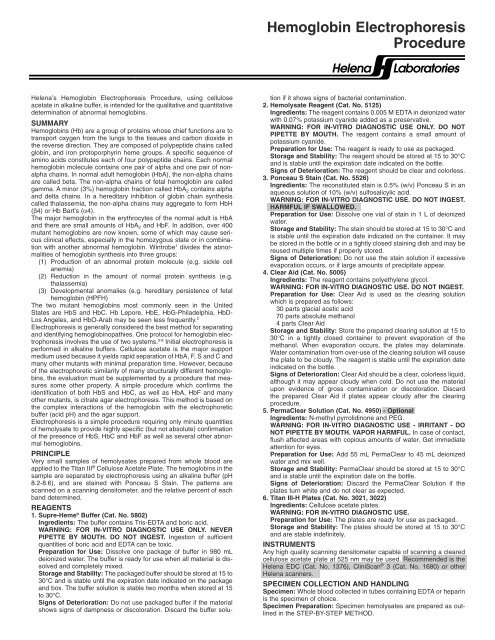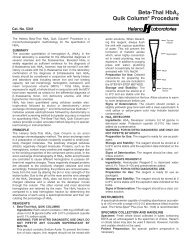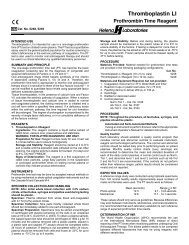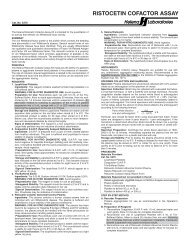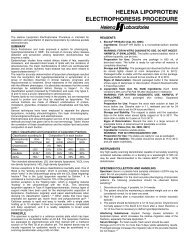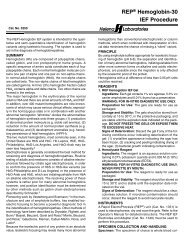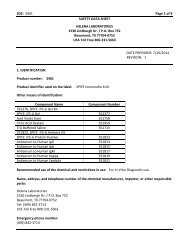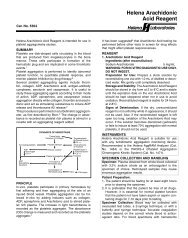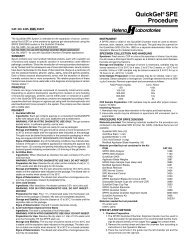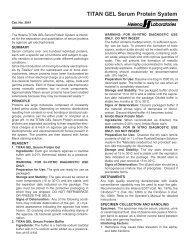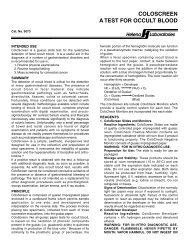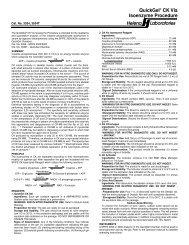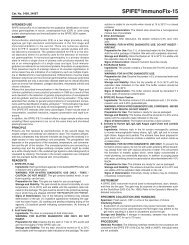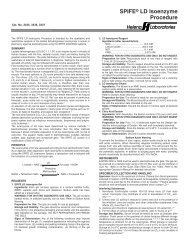Hemoglobin Electrophoresis Procedure - Helena Laboratories
Hemoglobin Electrophoresis Procedure - Helena Laboratories
Hemoglobin Electrophoresis Procedure - Helena Laboratories
Create successful ePaper yourself
Turn your PDF publications into a flip-book with our unique Google optimized e-Paper software.
<strong>Hemoglobin</strong> <strong>Electrophoresis</strong><strong>Procedure</strong><strong>Helena</strong><strong>Laboratories</strong><strong>Helena</strong>’s <strong>Hemoglobin</strong> <strong>Electrophoresis</strong> <strong>Procedure</strong>, using celluloseacetate in alkaline buffer, is intended for the qualitative and quantitativedetermination of abnormal hemoglobins.SUMMARY<strong>Hemoglobin</strong>s (Hb) are a group of proteins whose chief functions are totransport oxygen from the lungs to the tissues and carbon dioxide inthe reverse direction. They are composed of polypeptide chains calledglobin, and iron protoporphyrin heme groups. A specific sequence ofamino acids constitutes each of four polypeptide chains. Each normalhemoglobin molecule contains one pair of alpha and one pair of nonalphachains. In normal adult hemoglobin (HbA), the non-alpha chainsare called beta. The non-alpha chains of fetal hemoglobin are calledgamma. A minor (3%) hemoglobin fraction called HbA 2 contains alphaand delta chains. In a hereditary inhibition of globin chain synthesiscalled thalassemia, the non-alpha chains may aggregate to form HbH(β4) or Hb Bart’s (α4).The major hemoglobin in the erythrocytes of the normal adult is HbAand there are small amounts of HbA 2 and HbF. In addition, over 400mutant hemoglobins are now known, some of which may cause seriousclinical effects, especially in the homozygous state or in combinationwith another abnormal hemoglobin. Wintrobe 1 divides the abnormalitiesof hemoglobin synthesis into three groups:(1) Production of an abnormal protein molecule (e.g. sickle cellanemia)(2) Reduction in the amount of normal protein synthesis (e.g.thalassemia)(3) Developmental anomalies (e.g. hereditary persistence of fetalhemoglobin (HPFH)The two mutant hemoglobins most commonly seen in the UnitedStates are HbS and HbC. Hb Lepore, HbE, HbG-Philadelphia, HbD-Los Angeles, and HbO-Arab may be seen less frequently. 2<strong>Electrophoresis</strong> is generally considered the best method for separatingand identifying hemoglobinopathies. One protocol for hemoglobin electrophoresisinvolves the use of two systems. 3-8 Initial electrophoresis isperformed in alkaline buffers. Cellulose acetate is the major supportmedium used because it yields rapid separation of HbA, F, S and C andmany other mutants with minimal preparation time. However, becauseof the electrophoretic similarity of many structurally different hemoglobins,the evaluation must be supplemented by a procedure that measuressome other property. A simple procedure which confirms theidentification of both HbS and HbC, as well as HbA, HbF and manyother mutants, is citrate agar electrophoresis. This method is based onthe complex interactions of the hemoglobin with the electrophoreticbuffer (acid pH) and the agar support.<strong>Electrophoresis</strong> is a simple procedure requiring only minute quantitiesof hemolysate to provide highly specific (but not absolute) confirmationof the presence of HbS, HbC and HbF as well as several other abnormalhemoglobins.PRINCIPLEVery small samples of hemolysates prepared from whole blood areapplied to the Titan III ® Cellulose Acetate Plate. The hemoglobins in thesample are separated by electrophoresis using an alkaline buffer (pH8.2-8.6), and are stained with Ponceau S Stain. The patterns arescanned on a scanning densitometer, and the relative percent of eachband determined.REAGENTS1. Supre-Heme ® Buffer (Cat. No. 5802)Ingredients: The buffer contains Tris-EDTA and boric acid.WARNING: FOR IN-VITRO DIAGNOSTIC USE ONLY. NEVERPIPETTE BY MOUTH. DO NOT INGEST. Ingestion of sufficientquantities of boric acid and EDTA can be toxic.Preparation for Use: Dissolve one package of buffer in 980 mLdeionized water. The buffer is ready for use when all material is dissolvedand completely mixed.Storage and Stability: The packaged buffer should be stored at 15 to30°C and is stable until the expiration date indicated on the packageand box. The buffer solution is stable two months when stored at 15to 30°C.Signs of Deterioration: Do not use packaged buffer if the materialshows signs of dampness or discoloration. Discard the buffer solutionif it shows signs of bacterial contamination.2. Hemolysate Reagent (Cat. No. 5125)Ingredients: The reagent contains 0.005 M EDTA in deionized waterwith 0.07% potassium cyanide added as a preservative.WARNING: FOR IN-VITRO DIAGNOSTIC USE ONLY. DO NOTPIPETTE BY MOUTH. The reagent contains a small amount ofpotassium cyanide.Preparation for Use: The reagent is ready to use as packaged.Storage and Stability: The reagent should be stored at 15 to 30°Cand is stable until the expiration date indicated on the bottle.Signs of Deterioration: The reagent should be clear and colorless.3. Ponceau S Stain (Cat. No. 5526)Ingredients: The reconstituted stain is 0.5% (w/v) Ponceau S in anaqueous solution of 10% (w/v) sulfosalicylic acid.WARNING: FOR IN-VITRO DIAGNOSTIC USE. DO NOT INGEST.HARMFUL IF SWALLOWED.Preparation for Use: Dissolve one vial of stain in 1 L of deionizedwater.Storage and Stability: The stain should be stored at 15 to 30°C andis stable until the expiration date indicated on the container. It maybe stored in the bottle or in a tightly closed staining dish and may bereused multiple times if properly stored.Signs of Deterioration: Do not use the stain solution if excessiveevaporation occurs, or if large amounts of precipitate appear.4. Clear Aid (Cat. No. 5005)Ingredients: The reagent contains polyethylene glycol.WARNING: FOR IN-VITRO DIAGNOSTIC USE. DO NOT INGEST.Preparation for Use: Clear Aid is used as the clearing solutionwhich is prepared as follows:30 parts glacial acetic acid70 parts absolute methanol4 parts Clear AidStorage and Stability: Store the prepared clearing solution at 15 to30°C in a tightly closed container to prevent evaporation of themethanol. When evaporation occurs, the plates may delaminate.Water contamination from over-use of the clearing solution will causethe plate to be cloudy. The reagent is stable until the expiration dateindicated on the bottle.Signs of Deterioration: Clear Aid should be a clear, colorless liquid,although it may appear cloudy when cold. Do not use the materialupon evidence of gross contamination or discoloration. Discardthe prepared Clear Aid if plates appear cloudy after the clearingprocedure.5. PermaClear Solution (Cat. No. 4950) - OptionalIngredients: N-methyl pyrrolidinone and PEG.WARNING: FOR IN-VITRO DIAGNOSTIC USE - IRRITANT - DONOT PIPETTE BY MOUTH. VAPOR HARMFUL. In case of contact,flush affected areas with copious amounts of water. Get immediateattention for eyes.Preparation for Use: Add 55 mL PermaClear to 45 mL deionizedwater and mix well.Storage and Stability: PermaClear should be stored at 15 to 30°Cand is stable until the expiration date on the bottle.Signs of Deterioration: Discard the PermaClear Solution if theplates turn white and do not clear as expected.6. Titan III-H Plates (Cat. No. 3021, 3022)Ingredients: Cellulose acetate plates.WARNING: FOR IN-VITRO DIAGNOSTIC USE.Preparation for Use: The plates are ready for use as packaged.Storage and Stability: The plates should be stored at 15 to 30°Cand are stable indefinitely.INSTRUMENTSAny high quality scanning densitometer capable of scanning a clearedcellulose acetate plate at 525 nm may be used. Recommended is the<strong>Helena</strong> EDC (Cat. No. 1376), CliniScan ® 3 (Cat. No. 1680) or other<strong>Helena</strong> scanners.SPECIMEN COLLECTION AND HANDLINGSpecimen: Whole blood collected in tubes containing EDTA or heparinis the specimen of choice.Specimen Preparation: Specimen hemolysates are prepared as outlinedin the STEP-BY-STEP METHOD.
Specimen Storage and Stability: Whole blood samples may bestored up to one week at 2 to 6°C.PROCEDUREMaterials Provided: The following materials needed for the procedureare available from <strong>Helena</strong> <strong>Laboratories</strong>.Hardware Cat. No.Super Z-12 Applicator Kit (12 samples) 4093Super Z Applicator Kit (8 samples) 4088Zip Zone Chamber 1283Microdispenser and Tubes 60081000 Staining Set 5122Bufferizer 5093I.O.D. 5116Titan Plus Power Supply 1504ConsumablesTitan ® III-H Cellulose Acetate (94 mm x 76 mm)-12 samples 3021Titan ® Cellulose Acetate (76 mm x 60 mm)-8 samples 3022Supre-Heme Buffer 5802Hemo AFSA 2 Control 5330Hemo AA 2 Control 5328Hemo AFSC Control 5331Hemo ASA 2 Control 5329Hemolysate Reagent 5125Ponceau S 5526Clear Aid 5005Titan Blotter Pads 5034Zip Zone ® Prep 5090Titan Plastic Envelopes 5052<strong>Helena</strong> Marker 5000Identification Labels 5006Zip Zone ® Chamber Wicks 5081Glue Stick 5002PermaClear 4950Materials Needed, but not Provided:Glacial acetic acidAbsolute methanol5% acetic acid – Mix 5 parts of glacial acetic acid with 95 partsdeionized water.SUMMARY OF CONDITIONSPlate ................................................................................Titan ® III-HBuffer...............Supre-Heme ® dissolved in 980 mL deionized waterSoaking Time for Plates ....................................................5 minutesSample Size (hemolysate).........................................................5 µLNumber of Applications ........................................................One (1)<strong>Electrophoresis</strong> Time.......................................................25 minutesVoltage ...............................................................................350 voltsStaining Time (total) ........................................................20 minutesDrying Time........................................................10 minutes at 56°CScanning Wavelength...........................................................525 nmSTEP BY STEP METHODA. Preparation of the Titan ® III-H Plate1. Dissolve one package Supre-Heme ® Buffer in 980 mL deionizedwater.2. Properly code the required number ofTitan ® III-H Plates by marking on theglossy hard side with a marker.3. Soak the required number of plates inSupre-Heme ® Buffer for 5 minutes.The plates should be soaked in the bufferizeraccording to the instructions provided.Alternately, the plates may be wettedby slowly and uniformly lowering a rack ofplates into the buffer.The same soaking buffer may be used for soaking up to 12 platesor for approximately one week if stored tightly closed. If used fora prolonged period, residual solvents from the plates may buildup in the buffer and cause poor separation of the proteins or,evaporation may cause greater buffer concentration.B. Preparation of Zip Zone ® Chamber1. Pour approximately 100 mL ofSupre-Heme ® Buffer into each ofthe outer sections of the Zip Zone ®Chamber.2. Wet two chamber wicks in thebuffer and drape one over eachsupport bridge being sure it makescontact with the buffer and thatthere are no air bubbles under the wicks.3. Cover the chamber to prevent buffer evaporation. Discard thebuffer and wicks after use.C. Sample Preparation and Application1. Prepare a hemolysate of the patient samples as follows:a. Using whole blood: Add 1 part whole blood to 3 partsHemolysate Reagent. Mix well and allow to stand 5 minutes.b. Using packed cells: Mix 1 part packed red blood cells to 6parts Hemolysate Reagent. Mix well and allow to stand 5 minutes.NOTE: If removal of denatured hemoglobins from thesample is deemed necessary, see the Alternate SamplePreparation <strong>Procedure</strong>.2. Place 5 µL of the patienthemolysates or 5 µL of the HemoControls into the wells of theSample Well Plates using theMicrodispenser. Do not prepare ahemolysate of the Hemo Controls.3. To prevent evaporation, cover theSample Well Plate with a glassslide, if the samples are not usedwithin 2 minutes.4. Prime the applicator by depressing the tips into the sample wells3 or 4 times. Apply this loading to a piece of blotter paper. Primingthe applicator makes the second loading much more uniform. Donot load applicator again at this point, but proceed quickly to thenext step.HELENA1 2 3 4 5 6 7 85. Remove the wetted Titan ® III Plate from the buffer with the fingertipsand blot once firmly between two blotters. Place the platein the aligning base, cellulose acetate side up, aligning the topedge of the plate with the black scribe line marked “CATHODEAPPLICATION”. The identificationmark should bealigned with sample No. 1.Before placing the plate in thealigning base, place a drop ofwater or buffer on the centerof the aligning base. This preventsthe plate from shiftingduring the sample application.CATHODE APPLICATION6. Apply the sample to the plateby depressing the applicatortips into the sample well 3 or 4CENTER APPLICATIONHELENA LABORATORIEStimes and promptly transferringthe applicator to the aligningbase. Press the buttondown and hold it 5 seconds.1 2 3SUPER-CPK456 7 8Alternate Sample Preparation <strong>Procedure</strong>:If removal of denatured hemoglobins from the sample is deemed necessary,perform the following steps:a. Centrifuge the blood sample at 3500 RPM for 5 minutes.b. Remove the plasma from the sample and wash the red bloodcells in 0.85% saline (v/v) three times. After each wash, centrifugethe cells for 10 minutes at 3500 RPM.c. Add 1 volume deionized water and 1/4 volume toluene (orcarbon tetrachloride) to the washed red cells. Vortex at highspeed for one minute. Centrifuge the samples at 3500 RPM for10 minutes.d. If toluene is used, the top layer in the tube will contain cellstroma and should be removed with a capillary pipette beforeproceeding to the next step. The clear middle layer contains thedesired sample. If carbon tetrachloride is used, all red cellwaste material will be contained in the bottom of the tube aftercentrifugation.e. Filter the clear red solution through two layers of Whatman #1filter paper.HELENA1 2 3 4 5 6 7 81 2 31 2 3 4 5 6 7 8HELENA LABORATORIESSUPER-CPK456 7 8
D. <strong>Electrophoresis</strong> of Sample Plate1. Quickly place the plate in the electrophoresischamber, celluloseacetate side down, such that thesample end is toward the cathodic(-) side of the chamber. Place aweight (glass slide, etc.) on theplate to insure contact with thewicks.2. Place the cover on the chamber, and electrophorese the plate for25 minutes at 350 volts.E. Staining the <strong>Hemoglobin</strong> Bands1. Remove the plates from the electrophoresis chamber and stainin Ponceau S for 5 minutes.2. Destain in 3 successive washes of 5% acetic acid. Allow theplates to stay in each wash 2 minutes or until the background iswhite.3. The plates may be dried and stored for a permanent record atthis point. If a transparent background is desired for densitometry,proceed to the next step.If using Clear Aid Solution:4. Dehydrate, by washing the plate twice in absolute methanol, fortwo minutes each wash. Allow the plate to drain for 5-10 secondsbefore placing in the next solution.5. Place the plate into the Clear Aid solution for 5-10 minutes.6. Drain off excess solution. Then place the plate, acetate side up,onto a blotter, and into an I.O.D., Micro-Hood, or other dryingoven at 50-60°C for 15 minutes or until dry.If using PermaClear Solution:4. Place the plate(s) into the diluted PermaClear clearing solutionfor 2 minutes.5. Drain off excess solution by holding plate(s) vertically for 1minute. Then place the plate, acetate side up, onto a blotter, andinto an I.O.D., or other drying oven at 50-60°C for 15 minutes oruntil dry.F. Evaluation of the <strong>Hemoglobin</strong> Bands1. Qualitative evaluation: The hemoglobin plates may be inspectedvisually for the presence of abnormal hemoglobin bands. The<strong>Helena</strong> Hemo Controls provide a marker for band identification.2. Quantitative evaluation: Determine the relative percent of eachhemoglobin band by scanning the cleared and dried plates in thedensitometer using a 525 nm filter.Stability of End Product: The dried plates are stable for an indefiniteperiod of time, and may be stored in Titan Plastic Envelopes.Calibration: A calibration curve is not necessary because relative concentrationof the bands is the only parameter determined.Quality Control: Four controls for hemoglobin electrophoresis areavailable from <strong>Helena</strong> <strong>Laboratories</strong>: AA 2 Hemo Control (Cat. No. 5328),ASA 2 Hemo Control (Cat. No. 5329), AFSA 2 Hemo Control (Cat. No.5330), and AFSC Hemo Control (Cat. No. 5331). The controls shouldbe used as markers for the identification of the hemoglobin bands, andthey may be quantitated for verification of the accuracy of the procedure.Refer to the package insert provided with the controls for assayvalues and migration patterns. Use at least one of these controls oneach plate run.RESULTSFigures 1 illustrates how the combination of cellulose acetate and citrateagar electrophoresis can be used in tandem for the identification ofhemoglobins. Figure 2 lists the relative mobilities of various hemoglobinmutants on cellulose acetate and citrate agar plates.Calculation of Unknown: The <strong>Helena</strong> EDC, CliniScan ® 3 and other<strong>Helena</strong> densitometers with computer accessories will automaticallyprint the relative percent of the bands.LIMITATIONSSome abnormal hemoglobins have similar electrophoretic mobilitiesand must be differentiated by other methodologies.Further testing required:1. Citrate agar electrophoresis may be a necessary follow-up test forconfirmation of abnormal hemoglobins detected on cellulose acetate.2. Isoelectric focusing, high performance liquid chromatography, globinchain analysis (both acid and alkaline) and structural studies may benecessary in order to positively identify some of the more rare hemoglobins.3. Anion exchange column chromatography is the most accuratemethod for quantitating HbA 2 . <strong>Helena</strong> <strong>Laboratories</strong>’ Sickle-Thal QuikColumn ® Method (Cat. No. 5334) for quantitation of HbA 2 in the presenceof HbS, or the Beta-Thal HbA 2 Quik Column ® <strong>Procedure</strong> (Cat.No. 5341) are recommended. HbA 2 quantitation is one of the mostimportant diagnostic tests in the diagnosis of β-thalassemia trait.EWS4. Low levels of HbF (1-10%) may be accurately quantitated by radialimmunodiffusion using the <strong>Helena</strong> HbF-QUIPlate <strong>Procedure</strong> (Cat.No. 9325).(+) Cellulose Acetate (-) (+) Citrate Agar (-)A F S A 2DG CEOApplication PointAD Los AngelesAS-G PhiladelphiaA HasharonAO-ArabAFSC ControlFigure 1. Electrophoretic Mobilities of <strong>Hemoglobin</strong>s on Titan ® IIICellulose Acetate and on Titan ® IV Citrate Agar.SC*ELeporeG PhiladelphiaD PunjabO-Arab*HasharonHConstant SpringMalmoA 2'WoodBarts*KölnN BaltimoreASG PhiladelphiaJ OxfordJ Baltimore*Tacoma*Lufkin*CamperdownKHopeCamdemNew York*G San JoseC HarlemFigure 2. Relative Electrophoretic Mobilities of <strong>Hemoglobin</strong>s onCelulose Acetate and Citrate Agar. 11REFERENCE VALUESAt birth, the majority of hemoglobin in the erythrocytes of the normalindividual is fetal hemoglobin, HbF. Some of the major adult hemoglobin,HbA, and a small amount of HbA 2 , are also present. At the end ofthe first year of life and through adulthood, the major hemoglobin presentis HbA with up to 3.5% HbA 2 and less than 2% HbF.CCellulose AcetateS A FA2DEGAEFACFASCitrate AgarMethemoglobin+ 0 -2.6 -5.2 -10 –A F S A2– -4.4 -0 +5.8 +10 +F A S C-5.2+5.8-10+10-100-50-5.20-5.20-9.7+1.7-5.5+6.25+8.50-11.90+0.50+7.6+6.60+4.6+4.3+0.9+3.2+0.8+0.8+1.6+1.5-3.6-5.2-11.1O Arab - Migration varies on citrate agar from <strong>Hemoglobin</strong> A through <strong>Hemoglobin</strong> S.J Baltimore - Trait is approximately 50% of the total.J Oxford - Trait is approximately 25% of the total.*Unstable hemoglobinD Los Angeles and D Punjab are the same hemoglobin.C Harlem and Georgetown are the same hemoglobin.Köln is broadly smudged on both media possibly due to instability.-10-7.5-10.0-1.10-2.25-4.0-2.5-4.0-4.0-2.800 +5.8000000+7.5+5.8


